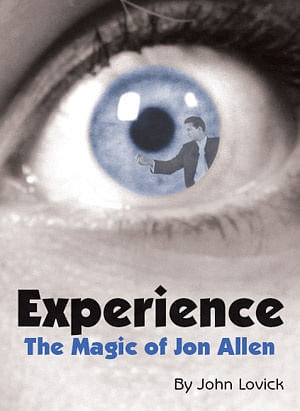Experience: The Magic of Jon Allen by John Lovick
Reviewed by Jamy Ian Swiss (originally published in Genii September, 2009)

Jon Allen is a full-time close-up magician in England, who has also successfully released several tricks in the magic marketplace, and has done well in the world of magic contests, having taken first place in close-up magic at both the International Brotherhood of Magicians in the U.S. and The Magic Circle in the U.K. A lot of what passes for content in the magic world these days consists of little more than puked-up chunks of undigested muck floating in a bile of raw ambition; hence it was a pleasant palate refreshment to read this collection of material that reflects both a track record and a consistent point of view. Books like this are a dwindling lot, so you might want to buy this one just to demonstrate that the desire for quality is not dead, and to encourage magic's more serious publishers and creators to not yet abandon the notion of giving and getting something for something.
Presenting more than 50 items in seven chapters, the book yields much muscle and little fat in its crisp 200 pages, leanly described John Lovick (following a foreword by Gregory Wilson, proving that magic publishing can make for strange bedfellows).
The first chapter describes Mr. Allen's prize-winning I.B.M. close-up act. I'm not much of a fan of that which generally appeals to magic contest judges, who almost invariably, particularly over the past 20 years or thereabouts, prefer novelty over quality when faced with the choice (albeit at times quality may barely appear on the menu). That said, Mr. Allen's act, while it does include some deliberate and clever plays on the knowledge and tastes of contest judges, actually includes material that can be used in real world working conditions. So putting aside, for example, a Coin Assembly and a Triumph: variation that are designed to surprise and possibly fool magicians, at least two other items have significant commercial potential, including the opening production of a giant (24") cigarette followed by a suitably huge matchstick; and a routine in which a borrowed ring ends up in a paper party popper. This latter effect is smartly routined and choreographed into the larger act, but could readily be adapted to less elaborate management. And, for what it's worth, if you're inclined to enter a close-up magic contest, you would do well to consider the thinking behind many of Mr. Allen's choices.
Chapter 2 is in many ways the price-of-the-book section, in that it includes 13 commercial close-up routines, none of which use playing cards. The chapter opens with a very strong version of John Kennedy's "Floating Bill," based on Jon LeClair's handling. Mr. Allen has selected two strong elements of the effect and limited his routine to just those, resulting in an effect of animation rather than levitation. This is one of the best pieces of thread work I've come across in quite some time. This same chapter also includes an offbeat version of a bending coin that happens in a spectator's hand, using a basic gimmick you probably have in the drawer. And for those who are fans of rubber band magic, there is a multi-phase routine here that thoughtfully combines a number of neo-classics in the field into a well-constructed progression.
Chapter 3 brings us to card tricks, and its dozen entries again reflect some offbeat but commercial ideas, including a thought-of "Card on Ceiling" (including a useful "think of-a-card" idea by Stephen Mulhern), and a thought-of Card in Envelope, that presents a clever application of the "Out-To-Lunch" principle.
Chapter 4 includes five pieces of stand-up magic, beginning with a smart variant handling of the commercially marketed "Splash!" bottle production from balloon. This chapter concludes Section 1 of the book; Section 2 varies more widely to address "Moves, Sequences & Bits of Business" as well as some miscellaneous effects, including a version of the hoary old "Prayer Vase" illusion done with two balloons, a very interesting oddity.
Finally, Section 3 includes several thought-provoking pieces, including a version of the Ambitious Card, dubbed "Adlibitious Card," which produces a different presentation each time you perform it. Mr. Allen also explains in this chapter how he uses his marketed "Destination Box" (a version of the Bruno Hennig "Card in Box" that also incorporates a widely used addition of my own) in his own walk-around work. And the book concludes with "Schrodinger's Card," a provocative approach to the Card in Envelope which leaves the spectator with a memorable "impossible object."
Perhaps the most satisfying aspect of this book is that Mr. Allen actually has some idea about why he does what he does the way he does it. This is not a book of killer sleight of-hand, nor of remarkable engineering, nor of poetic or elaborate theatrical scripting. But the word "experience" in the title is a double entendre of sorts, reflecting not only a subtle message about Mr. Allen's resume, but more so the notion that what counts in magic is not merely deception or entertainment, but the experience of the audience. Mr. Allen takes deadly and immensely pragmatic aim at his goal of engaging audiences and leaving them with a memorable experience, and I have little doubt he hits the target far more often than not. Others may and should choose to reach such a target via different paths. But rather than aimlessly shooting magic in any, or every, poorly focused direction available, just having such a well-defined target in mind is a vastly superior approach, and Mr. Allen arms readers with substantial weaponry in pursuit of that aim.

